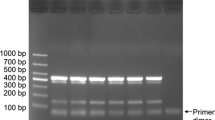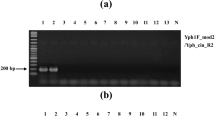Abstract
Cassava (Manihot esculenta), an important multipurpose crop, represents a food source for millions of people and a source of industrial raw material in tropical regions. A limitation in its production is cassava bacterial blight (CBB), a disease caused by Xanthomonas axonopodis pv. manihotis (Xam). CBB is spread mainly by propagation of infected cuttings, therefore early pathogen detection and disease diagnosis are crucial to prevent its dispersal and the consequent negative impact on the crop. A previously reported detection method was inefficient at detecting isolates of Xam more recently collected in cassava fields in Colombia. Consequently, a new method for pathogen detection was developed using multiplex nested PCR. A set of primers was selected amongst a group designed for five housekeeping gene sequences (rpoB, gltA, ftsZ, gyrB and groEL), and for the region of the gene encoding for the C-terminal portion of TALE1Xam, a protein involved in virulence of Xam. In this work, a multiplex nested PCR based on the set of primers RpoB and Cterm was optimized to achieve an effective detection of Xam. The developed method successfully detects the presence of Xam in cassava plants collected in infected fields.







Similar content being viewed by others
References
Boucher C, Barberis A, Trigalet DD (1985) Transposon mutagenesis of Pseudomonas solanacearum: isolation of Tn5-induced avirulent mutants. Journal of General Microbiology 131:2449–2457
Castiblanco LF, Gil J, Rojas A, Osorio D, Gutiérrez S, Muñoz-Bodnar A, Bernal AJ (2013) TALE1 from Xanthomonas axonopodis pv. manihotis acts as a transcriptional activator in plant cells and is important for pathogenicity in cassava plants. Molecular Plant Pathology 14:84–95
FAO (2013) Food and Agriculture Organization of the United Nations. Save and grow cassava: A guide to sustainable production intensification. Available at http://www.fao.org/3/a-i3278e.pdf
Goodwin SB, Drenth A, Fry WE (1992) Cloning and genetic analyses of two highly polymorphic, moderately repetitive nuclear DNAs from Phytophtora infestans. Current Genetics 22:107–115
Grund E, Darissa O, Adam G (2010) Application of FTA®cards to sample microbial plant pathogens for PCR and RT-PCR. Journal of Phytopathology 158:750–757
Gutiérrez-Aguirre I, Rački N, Dreo T, Ravnikar M (2015) Droplet digital PCR for absolute quantification of pathogens. Methods in Molecular Biology 1302:331–347
Lindsey RL, Fedorka-Cray PJ, Abley M, Turpin JB, Meinersmann RJ (2015) Evaluating the occurrence of Escherichia albertii in chicken carcass rinses by PCR, Vitek analysis, and sequencing of the rpoB gene. Applied and Environmental Microbiology 81:1727–1734
López CE, Bernal AJ (2012) Cassava bacterial blight: using genomics for the elucidation and management of an old problem. Tropical Plant Biology 5:117–126
López CE, Quesada-Ocampo LM, Bohórquez A, Duque MC, Vargas J, Tohme J, Verdier V (2007) Mapping EST-derived SSRs and ESTs involved in resistance to bacterial blight in Manihot esculenta. Genome 50:1078–1088
Lozano JC (1986) Cassava bacterial blight: a manageable disease. Plant Disease 70:1089–1093
Mansfield J, Genin S, Magori S, Citovsky V, Sriariyanum M, Ronald P, Foster GD (2012) Top 10 plant pathogenic bacteria in molecular plant pathology. Molecular Plant Pathology 13:614–629
Marchesi JR, Sato T, Weightman AJ, Martin TA, Fry JC, Hiom SJ, Dymock D, Wade WG (1998) Design and evaluation of useful bacterium-specific PCR primers that amplify genes coding for bacterial 16S rRNA. Applied and Environmental Microbiology 64:795–799
Obradovic D, Kevresan S (2010) Optimization of PCR in application of hot start Taq DNA polymerase for detection of Erwinia amylovora with primers FER1-F and FER1-R1. Microbiology 79:816–821
Ojeda S, Verdier V (2000) Detecting Xanthomonas axonopodis pv. manihotis in cassava true seeds by nested polymerase chain reaction assay. Canadian Journal of Plant Pathology 22:241–247
Pelludat C, Duffy B, Frey JE (2009) Design and development of a DNA microarray for rapid identification of multiple European quarantine phytopathogenic bacteria. European Journal of Plant Pathology 125:413–423
Restrepo S, Velez CM, Duque MC, Verdier V (2004) Genetic structure and population dynamics of Xanthomonas axonopodis pv. manihotis in Colombia from 1995 to 1999. Applied and Environmental Microbiology 70:255–261
Restrepo S, Verdier V (1997) Geographical differentiation of the population of Xanthomonas axonopodis pv. manihotis in Colombia. Applied and Environmental Microbiology 63:4427–4434
Trujillo CA, Arias-Rojas N, Poulin L, Medina CA, Tapiero A, Restrepo S, Bernal AJ (2014) Population typing of the causal agent of cassava bacterial blight in the Eastern Plains of Colombia using two types of molecular markers. BMC Microbiology 14:161
Trujillo CA, Ochoa JC, Mideros MF, Restrepo S, López C, Bernal A (2014) A complex population structure of the cassava pathogen Xanthomonas axonopodis pv. manihotis in recent years in the Caribbean region of Colombia. Microbial Ecology 68:155–167
Verdier V (2002) Bacteriosis Vascular (o Añublo Bacteriano) de la Yuca 542 Causada por Xanthomonas axonopodis pv. manihotis. In: Ospina B, Ceballos H (eds) La yuca en el tercer milenio: Sistemas modernos de producción, procesamiento, utilización y comercialización. CIAT, Cali, pp 79–83.
Verdier V, Dongo P, Boher B (1993) Assessment of genetic diversity among strains of Xanthomonas campestris. Journal of General Microbiology 139:2591–2601
Verdier V, Mosquera G, Assigbétsé K (1998) Detection of the cassava bacterial blight pathogen, Xanthomonas axonopodis pv. manihotis, by polymerase chain reaction. Plant Disease 82:79–83
Verdier V, Ojeda S, Mosquera G (2001) Methods for detecting the cassava bacterial blight pathogen: a practical approach for managing the disease. Euphytica 120:103–107
Acknowledgements
We are thankful to Luis Miguel Rodriguez for support with databases, to Dr. Valerie Verdier (IRD, Montpellier, France) for providing reference strains and to Dr. Brian Staskawicz (University of California, Berkeley, USA) for providing the strains from Nigeria. This work was supported by the Ministerio de Agricultura de Colombia.
Author information
Authors and Affiliations
Corresponding author
Additional information
Section Editor: Alessandra A. de Souza
Electronic supplementary material
ESM 1
(DOCX 20 kb)
Rights and permissions
About this article
Cite this article
Bernal-Galeano, V., Ochoa, J.C., Trujillo, C. et al. Development of a multiplex nested PCR method for detection of Xanthomonas axonopodis pv. manihotis in Cassava. Trop. plant pathol. 43, 341–350 (2018). https://doi.org/10.1007/s40858-018-0214-4
Received:
Accepted:
Published:
Issue Date:
DOI: https://doi.org/10.1007/s40858-018-0214-4




